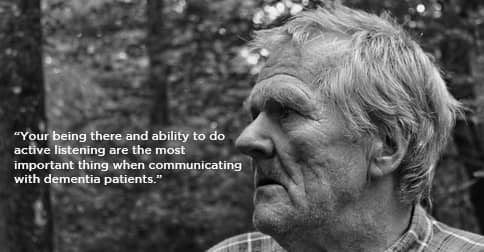Dementia Caregiver’s Guide

Alzheimer’s Association defined dementia as “a general term for loss of memory and other mental abilities.” The symptoms of dementia include difficulties with thinking, problem-solving and/or speaking. People with dementia may also experience changes in their moods or behaviors.
Last Tuesday (August 23), 25 caregivers, including Roxanne Brown from Right at Home of Lower Manhattan attended an interactive dementia training for caregiving professionals in the Brookdale Senior Living Solutions at Battery Park City.
The 3-hour seminar emphasized that listening and validating the feelings of a dementia patient can help to improve a patient’s life. As individuals with memory impairment might be unable to regulate their expressions or behaviors to reflect their feelings according to social cues, the training provided caregivers with communication strategies and techniques to help them connect with patients.

How to Communicate with Dementia Patients Effectively
Communicating with people who suffer from dementia is more than choosing your words carefully. Your being there and ability to do active listening are often more important. Roxanne shared her notes on communication strategies with us:
- Identify yourself
Approach the dementia patient from the front and tell him/her who you are. Keep good eye contact. If the person is seated or reclined, go down to his/her eye level. - Call the person by name
It helps to orient the patient and get his/her attention.’ - User short, simple words and sentences
Lengthy requests or stories can be overwhelming. Ask one question at a time. - Speak slowly and distinctively
Be aware of speed and clarity. Use a gentle and relaxed tone – a lower pitch is more calming. - Patiently wait for a response
The patient may need extra time to process what you said. - Repeat information or questions as needed
If the patient does not respond, wait a moment then ask again. - Turn questions into answers
Provide a solution instead of asking a question. For example, say “the bathroom is right here,” instead of “do you need to use the bathroom?” - Avoid confusing and vague statements
If you tell the patient to “hop in,” he/she may interpret your instructions literally. You should describe the action in a direct manner – “please come here, your shower is ready.” Avoid using “it” or “that,” name the object or place. Rather than saying “here it is,” try something like “here is your hat.”
Dementia and Alzheimer’s
Alzheimer’s disease is the most common form of dementia; it’s also the 5th leading cause of death in people older than 65. Today, 5.4 million Americans are diagnosed with Alzheimer’s. 1 in 8 people aged 65 or above has the disease, and the ratio goes up to 1 in 2 person for Americans aged 85 or above. Alzheimer’s and dementia are both more common in women than men. Alzheimer’s Association estimated that about 7.7 million people will be affected by 2030.



